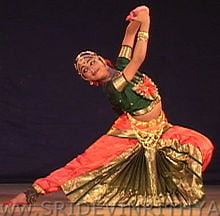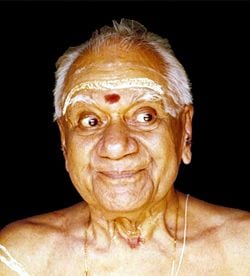Natya Shastra
The Nātya Shastra (Nātyaśāstra नाट्य शास्त्र) of Bharata is the principal work of dramatic theory, encompassing dance and music, in classical India. It is attributed to the muni (sage) Bharata and is believed to have been written during the period between 200 B.C.E. and 200 C.E.).
The text contains a set of precepts on the writing and performance of dance, music and theatre, and while it primarily deals with stagecraft, it has come to influence music, dance, and literature as well. Thus, an argument can be made that the Natyasastra is the foundation of the fine arts in India.
Date and authorship
The document is difficult to date and Bharata's historicity has also been doubted, some authors suggesting that it may be the work of several persons. However, Kapila Vatsyayan has argued[1] that based on the unity of the text, and the many instances of coherent reference of later chapters from earlier text, the composition is likely that of a single person. Whether his/her name really was Bharata is open to question[1]: near the end of the text we have the verse: "Since he alone is the leader of the performance, taking on many roles, he is called Bharata" (35.91[2]), indicating that Bharata may be a generic name. It has been suggested that Bharata is an acronym for the three syllables: bha for bhāva (mood), rā for rāga (melodic framework), and ta for tāla (rhythm). However, in traditional usage Bharata has been iconified as muni or sage, and the work is strongly associated with this personage.
Since nothing is known about Bharata, any arguments regarding date can be based solely on the text. It has been argued that the text predates several sections of the Ramayana, since the music terminology used by Valmiki follows Bharata's outlines. At the same time, it is clearly later than some of the Purana and Brahmana texts. Along with many other arguments, this has led to the opinion that the date may lie somewhere between 200B.C.E. and 200C.E. [2] [3] [4]. Though earlier and later dates are often postulated, this appears to be the "broad consensus"[1].
Title and setting
Written in Sanskrit, the text consists of 6,000 sutras, or verse stanzas, incorporated in 35 or 36 chapters. Some passages that are composed in a prose form.
The title can be loosely translated as A compendium of Theatre or a A Manual of Dramatic Arts. Nātya, or nāṭaka means Dramatic Arts. In contemporary usage, this word does not include dance or music, but etymologically the root naṭ refers to "dance."
The discourse is set in a frame where a number of munis approach Bharata, asking him about nāṭyaveda (lit. nāṭya=drama,performance; veda=knowledge). The answer to this question comprises the rest of the book, which is thus loosely a dialogue. Bharata says that all this knowledge is due to Brahma. At one point he mentions that he has a hundred "sons" who will spread this knowledge, which suggests that Bharata may have had a number of disciples whom he trained.
The creation by Brahma of natyaveda is associated with an egalitarian myth called the fifth veda: since the four vedas, also created by Brahma, were not to be studied by women and lower castes, he created this fifth veda, the art of drama, to be practiced by everyone[5].
Performance Art Theory
The Natya Shastra ranges widely in scope, from issues of literary construction, to the structure of the stage or mandapa, to a detailed analysis of musical scales and movements (murchhanas), to an analysis of dance forms that considers several categories of body movements, and their impacts on the viewer.
Bharata describes 15 types of drama ranging from one to ten acts. The principles for stage design are laid down in some detail. Individual chapters deal with aspects such as makeup, costume, acting, directing, etc. A large section deals with meanings conveyed by the performance (bhavas) get particular emphasis, leading to a broad theory of aesthetics (rasas).
Four kinds of abhinaya (acting, or histrionics) are described - that by body part motions (angika), that by speech (vAchika), that by costumes and makeup (AhArya), and the highest mode, by means of internal emotions, expressed through minute movements of the lips, eyebrows, ear, etc. (sAttvika)[5].
Rasa
The Nātyashāstra delineates a detailed theory of drama comparable to the Poetics of Aristotle. Bharata refers to bhavas, the imitations of emotions that the actors perform, and the rasas (emotional responses) that they inspire in the audience. He argues that there are eight principal rasas: love, pity, anger, disgust, heroism, awe, terror and comedy, and that plays should mix different rasas but be dominated by one.
Each rasa experienced by the audience is associated with a specific bhava portrayed on stage. For example, in order for the audience to experience srngara (the 'erotic' rasa), the playwright, actors and musician work together to portray the bhava called rati (love).
Music
After the Samaveda that dealt with ritual utterances of the Vedas, the Natyashastra is the first major text that deals with music at length. It is considered the defining treatise of Indian Classical Music until the 13th century, when the stream bifurcated into Hindustani classical music in North India and Pakistan, and Carnatic classical music in South India.
While much of the discussion of music in the Natyashastra focuses on musical instruments, it also emphasizes several theoretical aspects that remained fundamental to Indian music:
1. Establishment of Shadja as the first, defining note of the scale or grama. The word Shadja (षड्ज) means 'giving birth to six', and refers to the fact that once this note (often referred to as "sa" and notated S) is fixed, the placement of other notes in the scale is determined.
2. Principle of Consonance: Consists of two principles:
a. The first principle states that there exists a fundamental note in the musical scale which is Avinashi (अविनाशी) and Avilopi (अविलोपी) that is, the note is ever-present and unchanging.
b. The second principle, often treated as law, states that there exists a natural consonance between notes; the best between Shadja and Tar Shadja, the next best between Shadja and Pancham.
3. The Natyashastra also suggest the notion of musical modes or jatis which are the origin of the notion of the modern melodic structures known as ragas. Their role in invoking emotions are emphasized; thus compositions emphasizing the notes gandhara or rishabha are said to be related to tragedy (karuna rasa) whereas rishabha is to be emphasized for evoking heroism (vIra rasa). Jatis are elaborated in greater detail in the text Dattilam, composed around the same time as the Natyashastra.
The Natyashastra also suggests several aspects of musical performance, particularly its application to vocal, instrumental and orchestral compositions. It also deals with the rasas and bhavas that may be evoked by music.
Impact
Natyashastra remained an important text in the fine arts for many centuries; so much so that it is sometimes referred to as the fifth veda. Much of the terminology and structure of Indian classical music and Indian classical dance were defined by it. Many commentaries have expanded the scope of the Natya Shastra; most importantly we may include Matanga's Brihaddesi (5th-7th c.), Abhinavagupta's Abhinavabharati (which unifies some of the divergent structures that had emerged in the intervening years, and outlines a theory of artistic analysis) and Sharngadeva's Sangita Ratnakara (13th c. work that unifies the raga structure in music)[6]. The analysis of body forms and movements also influenced sculpture and the other arts in subsequent centuries[1]. The structures of music outlined in the Natya Shastra retain their influence even today, as seen in the seminal work Hindustani Sangeetha Padhathi[7] by Vishnu Narayan Bhatkhande from the early 20th century.
See also
- Navarasa
- Sanskrit Literature
- Nātyakalpadrumam
- Mani Madhava Chakyar
ReferencesISBN links support NWE through referral fees
- ↑ 1.0 1.1 1.2 1.3 Bharata: The Natyasastra (1996). Kapila Vatsyayan. Sahitya Akademi, New Delhi. p.6
- ↑ 2.0 2.1 Manmohan Ghosh, ed. (1950). Natyashastra,. Asiatic Society,. See introduction p. xxvi for discussion of dates
- ↑ M. Ramakrishna Ravi, (1956). Natyashastra, 2nd rev. ed.. Gaekwad Oriental Series,. See introduction for discussion of dates
- ↑ Kane, P.V. (1923). Introduction to Sanskrit Poetics. pp. viii-ix discusses dates
- ↑ 5.0 5.1 Dr. Asawari Bhat. Glimpses of Natyashastra. course notes, IIT Mumbai.
- ↑ http://www.musicalnirvana.com/introduction/origin2.html
- ↑ Hindustani Sangeetha Padhathi (4 volumes, Marathi) (1909-1932). Vishnu Narayan Bhatkhande. Sangeet Karyalaya (1990 reprint).
Other books and references
- Nanyadev. Bharat Bhashsya. Khairagarh Edition.
- Chākyār, Māni Mādhava. Nātyakalpadrumam, Sangeet Natak Academi, New Delhi, 1975
- Brahaspati, Dr. K C Dev. Bharat ka Sangeet Siddhant.
External links
Credits
New World Encyclopedia writers and editors rewrote and completed the Wikipedia article in accordance with New World Encyclopedia standards. This article abides by terms of the Creative Commons CC-by-sa 3.0 License (CC-by-sa), which may be used and disseminated with proper attribution. Credit is due under the terms of this license that can reference both the New World Encyclopedia contributors and the selfless volunteer contributors of the Wikimedia Foundation. To cite this article click here for a list of acceptable citing formats.The history of earlier contributions by wikipedians is accessible to researchers here:
The history of this article since it was imported to New World Encyclopedia:
Note: Some restrictions may apply to use of individual images which are separately licensed.

